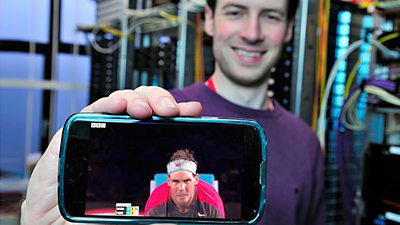We’ve been working with the mobile industry and other broadcasters to enhance the mobile standards for TV applications.

This is being presented at IBC 2023, alongside other work from Βι¶ΉΤΌΕΔ R&D:
- Live production using non-public 5G networks (winner of and an )
- Human Values content tools for user wellbeing ()
- 5G media streaming standalone networks ()
Why it matters
People increasingly expect Βι¶ΉΤΌΕΔ content to be available whenever and wherever they happen to be, but watching video on the move via apps such as puts great demand on the mobile network, even with the arrival of faster mobile data connections.
The more users try to consume data in one specific area, the more traffic has to be handled by the cell. Ultimately it can become congested and users could start to experience delays and buffering – as can sometimes be seen when trying to use the mobile network at sports or music events when big crowds are present.
One way to help tackle network congestion and offer more wide-spread coverage might be to use broadcast techniques.
This way, rather than establishing individual connections to every user, the cell emits a single broadcast of the data which is received by any user within the area it covers. This results in a big reduction in congestion, as the cell does not need to re-transmit a copy to every individual user.

Elsewhere, in other network technology developments, 5G offers the prospect of ever higher peak download speeds but these speeds are unlikely to be available everywhere and to everyone due to limitations of the physics of radio wave propagation and the practical costs of deployment - and there is a risk of a widening gap between haves and have-nots. Therefore we also need to work out how 5G can allow audiences to access the Βι¶ΉΤΌΕΔ’s services wherever they are.
What we're doing
We’ve been working with industry and other broadcasters within 3GPP, to .
The 3GPP standardisation work leads on from what we learnt from our involvement in and where we used LTE eMBMS (a broadcast mode already defined in the current 4G specifications) to broadcast live TV streams from the Commonwealth Games to handsets.

We continue to work closely with other broadcasters and the mobile community to look at further enhancements to the mobile standards as well as trying to work what 5G might mean for the Βι¶ΉΤΌΕΔ and its audiences through projects such as , our involvement in a fixed wireless access trial and our continued membership of the .
Outcomes
The 3GPP work has culminated in which includes features to specifically meet broadcaster requirements – a first for a mobile standard.
- -
- Βι¶ΉΤΌΕΔ R&D - All of our articles on 4G and 5G including:
- Βι¶ΉΤΌΕΔ R&D - Broadcasting Over 5G - Delivering Live Radio to Orkney
- Βι¶ΉΤΌΕΔ R&D - TV Over Mobile Networks - Βι¶ΉΤΌΕΔ R&D at the 3GPP
- Βι¶ΉΤΌΕΔ R&D - 5G-Xcast
- Βι¶ΉΤΌΕΔ R&D - 4G Broadcast for the Commonwealth Games 2014
- Βι¶ΉΤΌΕΔ R&D - 4G Broadcast technology trial at Wembley 2015 FA Cup Final
- Βι¶ΉΤΌΕΔ R&D - 4G Broadcast: Can LTE eMBMS Help Address the Demand for Mobile Video?
- Βι¶ΉΤΌΕΔ R&D - 5G Trials - Streaming AR and VR Experiences on Mobile
- Βι¶ΉΤΌΕΔ R&D - 5G Smart Tourism Trial at the Roman Baths
- Βι¶ΉΤΌΕΔ R&D - New Content Experiences over 5G Fixed Wireless Access
- Βι¶ΉΤΌΕΔ R&D - New Audience Experiences for Mobile Devices
- Βι¶ΉΤΌΕΔ R&D - Unlocking the Potential of 5G for Content Production
- Βι¶ΉΤΌΕΔ R&D - Building our own 5G Broadcast Modem
- Βι¶ΉΤΌΕΔ R&D - Broadcast Wi-Fi


